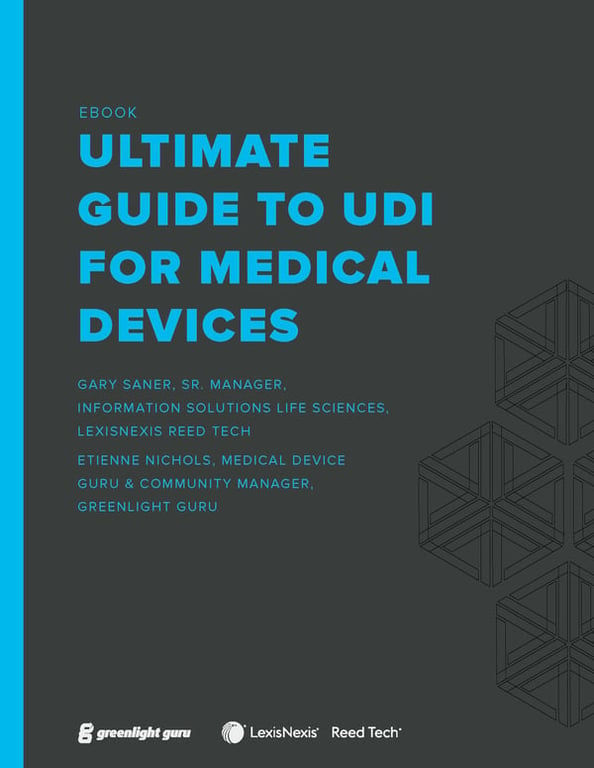Basic UDI-DI: What is it and How to Assign it for Your Medical Device

Unique device identification (UDI) provides a framework for identifying and tracing medical device distribution all over the world.
However, organizing this massive amount of data requires a great deal of oversight and regulation. If you’ve read our Ultimate Guide to UDI, you likely already know about the UDI-DI (device identification) and UDI-PI (production identification). If you haven’t checked it out, I recommend reading it for some important baseline knowledge on the subject.
Now, let’s take a look at a new bit of medical device nomenclature: the Basic UDI-DI.
What is Basic UDI-DI?
Basic UDI-DI (or BUDI-DI for short) is an entirely new method of device identification, one which groups together devices with multiple UDI-DIs. With Basic UDI-DI, the BUDI-DI number links devices with the same intended purpose, risk class, and essential design and manufacturing characteristics.
These are often referred to as a device “family,” with each connected model referred to as a “child” device to the “parent” model. These device families may take the form of a system or procedure pack.
It’s important to note that Basic UDI-DI does not replace UDI-DI. Basic UDI-DI is unrelated to packaging or labeling requirements of a device, and does not need to be directly marked on a physical product. The Basic UDI-DI was created primarily for regulatory and administrative purposes, as opposed to UDI-DI’s applications for device identification and traceability.
Where is Basic UDI-DI required?
Basic UDI-DI is unique to the EU Medical Device Regulation (EU MDR) framework and is required for submissions to the EUDAMED database. Once properly assigned, a Basic UDI-DI acts as the main key to all the associated child devices within a particular family.
References to the need for Basic UDI-DI can be found throughout numerous EU MDR-related documents such as:
- Technical documentation
- Summary of Safety and Clinical Performance (SSCP)
- EU Declaration of Conformity (DoC)
- Notified body certificates
- Certificate of Free Sale (CFS)
- Periodic Safety Update Report (PSUR)
- Post-market clinical investigations
- Performance study application in regulatory forms, such as a Manufacturer’s Incident Report
The only time a BUDI-DI is not required is for a custom-made device, as these types of devices generally do not fall under the umbrella of MDR or IVDR requirements for UDI.Lastly, if the device requires Notified Body review, then the BUDI-DI should also be listed on the CE Certification and the Certificate of Free Sale.
How does Basic UDI-DI work?
Basic UDI-DIs provide much-needed organization to EUDAMED entries. By linking multiple devices under a single BUDI-DI, any relevant updates in device documentation can be applied across the entire family of devices.
One important rule to remember is that there may only be one BUDI-DI assigned to multiple UDI-DI’s at any time. Similarly, there can never be multiple BUDI-DI’s linked to just one UDI-DI.
This rule is crucial for manufacturers to understand, as a BUDI-DI cannot be changed. If a change is required for a BUDI-DI, it would require a manufacturer to obtain an entirely new Basic UDI-DI. This would necessitate changes made individually to all UDI-DIs, a consequence that can lead to a major slowdown for manufacturers, providers, and potentially even end users.
One potential cause for a new Basic UDI-DI would be if a manufacturer were to relocate to another country, thus requiring a change to the name and address on the device label. This would then trigger the requirement for a new Single Registration Number (SRN) provided by a different competent authority.
And of course, that is all after the manufacturer information is verified, validated, and submitted to the Economic Operators (Actor) Registration module in EUDAMED.
How do I get a Basic UDI-DI?
According to the MDCG 2019-1 guidance for medical device software qualification and classification, device manufacturers have a legal responsibility to obtain and utilize a human-readable BUDI-DI assigned by an approved UDI issuing agency. Currently the only UDI agencies approved for use in the EU are:
- GS1
- HIBBC
- ICCBBA
- IFA
Once a device manufacturer has chosen an issuing agency, the guidelines state that the issuing agency must adhere to the following requirements:
- Create a code format that is close to the existing UDI-DI format
- Use no more than 25 total characters
- Assign a check/digit character that was determined by an algorithm
Achieve Success with Greenlight Guru
Whether it’s UDI, UDI-DI, UDI-PI, or BUDI-DI, medical device manufacturers like you know the importance of precision and traceability, all in the name of True Quality.
Our MedTech Suite integrates cross-functional teams, processes, and data throughout the product lifecycle, giving device companies full visibility and traceability beyond compliance requirements to proactively overcome execution gaps and accelerate success.
Ready to learn more? Get started today with a free personalized demo of Greenlight Guru →
Etienne Nichols is the Head of Industry Insights & Education at Greenlight Guru. As a Mechanical Engineer and Medical Device Guru, he specializes in simplifying complex ideas, teaching system integration, and connecting industry leaders. While hosting the Global Medical Device Podcast, Etienne has led over 200...
Related Posts
Ultimate Guide to UDI for Medical Devices
Explaining UDI Requirements for GUDID and EUDAMED
How to Integrate UDI into a Quality System for Your Medical Device
Get your free PDF
Ultimate Guide to UDI for Medical Devices
%20Ultimate-Guide-to-UDI.png?width=250&name=(cover)%20Ultimate-Guide-to-UDI.png)










